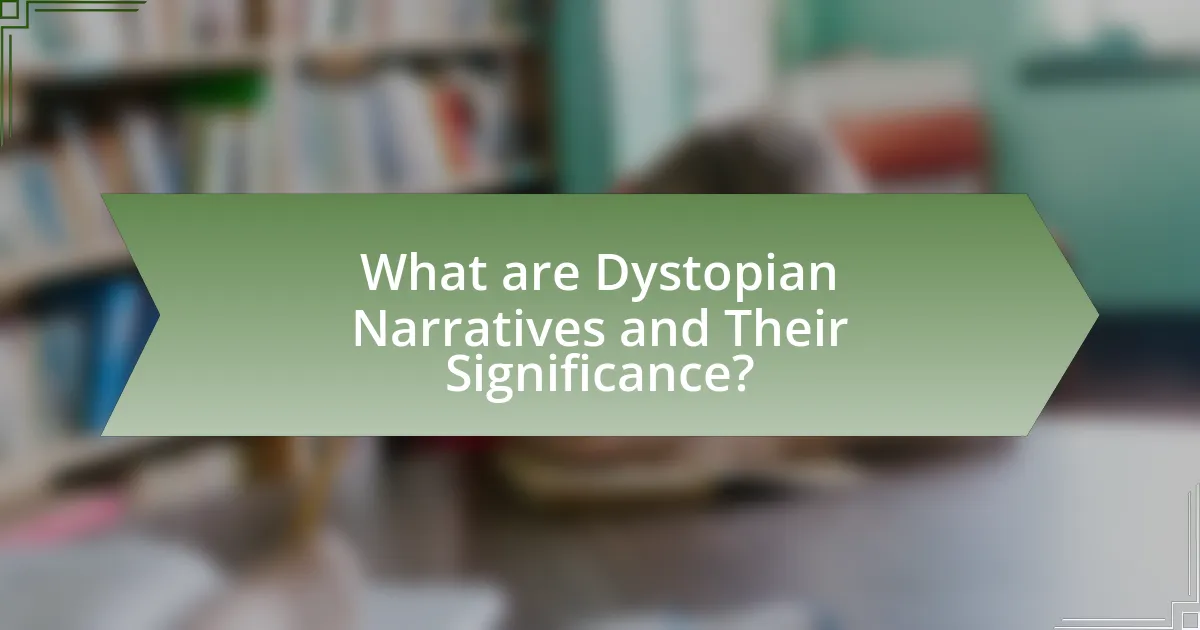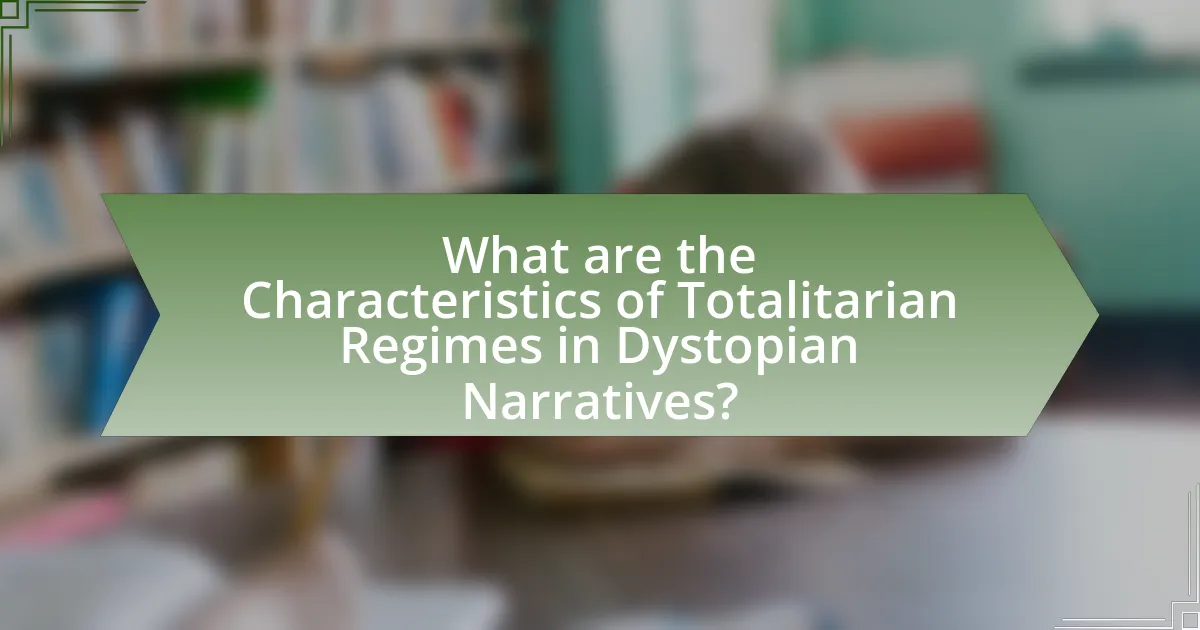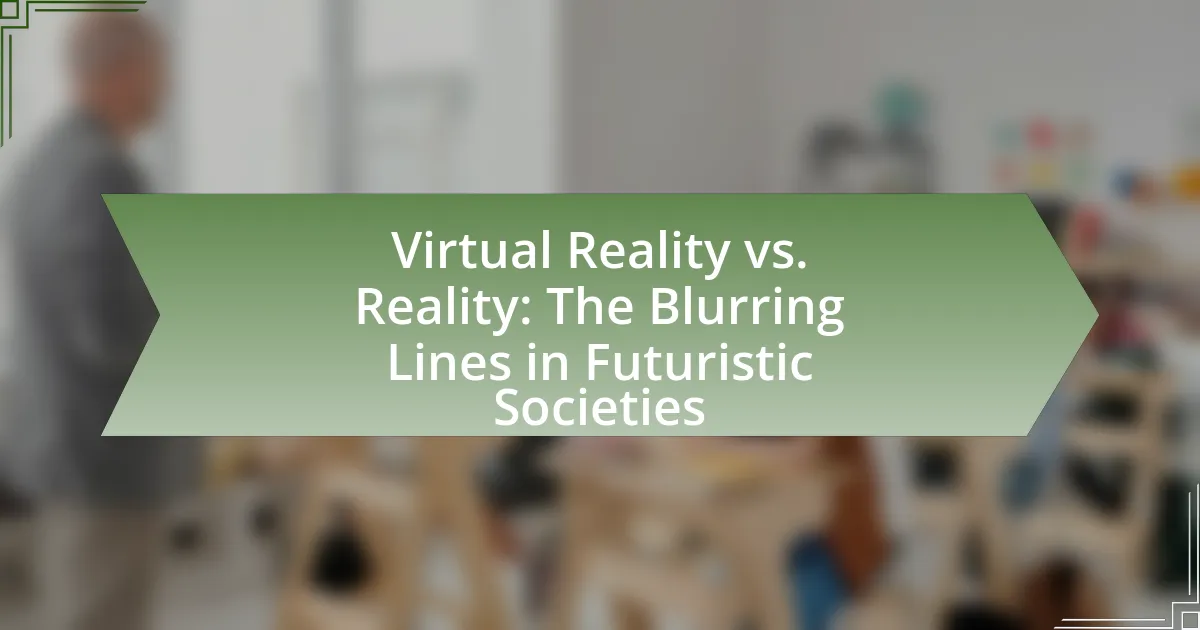Dystopian narratives are fictional works that explore societies under totalitarian regimes, emphasizing the consequences of oppressive governance and the erosion of individual freedoms. These narratives serve as cautionary tales, reflecting societal fears and historical events that shape their themes, such as surveillance, loss of individuality, and social inequality. The article examines how totalitarian regimes maintain control through propaganda and technology, the psychological impacts on individuals, and the long-term effects on societal values. Additionally, it discusses the ethical dilemmas posed by surveillance technology and the lessons these narratives offer regarding current political climates and strategies for resisting oppression.

What are Dystopian Narratives and Their Significance?
Dystopian narratives are fictional works that depict societies characterized by oppressive control, often under totalitarian regimes, highlighting the consequences of extreme political and social ideologies. These narratives serve as cautionary tales, illustrating the potential dangers of unchecked power and the loss of individual freedoms. For instance, George Orwell’s “1984” presents a society where surveillance and propaganda suppress dissent, emphasizing the risks of authoritarian governance. Such narratives are significant as they provoke critical reflection on contemporary societal issues, encouraging readers to consider the implications of their own political systems and the importance of safeguarding democratic values.
How do Dystopian Narratives reflect societal fears?
Dystopian narratives reflect societal fears by illustrating the consequences of oppressive regimes and the loss of individual freedoms. These narratives often depict scenarios where government control, surveillance, and dehumanization lead to societal collapse, mirroring real-world anxieties about authoritarianism and the erosion of civil liberties. For instance, George Orwell’s “1984” exemplifies fears of totalitarianism through its portrayal of a surveillance state that manipulates truth and suppresses dissent, resonating with historical instances such as the rise of fascism in the 20th century. Such narratives serve as cautionary tales, prompting audiences to confront and critically evaluate the implications of unchecked power and societal complacency.
What historical events have influenced Dystopian Narratives?
Historical events such as World War II, the rise of totalitarian regimes, and the Cold War have significantly influenced dystopian narratives. The atrocities committed during World War II, including the Holocaust, highlighted the dangers of unchecked power and authoritarianism, which are central themes in works like George Orwell’s “1984.” The establishment of totalitarian regimes in the 20th century, such as Stalin’s Soviet Union and Hitler’s Nazi Germany, provided real-world examples of oppressive governance, inspiring authors to explore the consequences of such systems in their narratives. Additionally, the Cold War era, characterized by nuclear threats and ideological conflicts, fueled fears of surveillance and loss of individual freedoms, further shaping dystopian literature, as seen in Aldous Huxley’s “Brave New World.” These historical contexts serve as a backdrop for the exploration of societal collapse and the human condition in dystopian fiction.
How do cultural contexts shape Dystopian Narratives?
Cultural contexts significantly shape dystopian narratives by influencing the themes, characters, and societal critiques presented in these stories. For instance, dystopian works often reflect the fears and values of the society in which they are created, such as George Orwell’s “1984,” which critiques totalitarianism and surveillance, resonating with post-World War II anxieties about authoritarian regimes. Additionally, cultural elements like religion, technology, and social norms inform the portrayal of dystopian futures, as seen in Margaret Atwood’s “The Handmaid’s Tale,” which draws on historical and contemporary issues of gender and power dynamics. These narratives serve as mirrors to cultural concerns, illustrating how specific societal contexts can dictate the nature of dystopian visions and the moral lessons they convey.
What themes are commonly explored in Dystopian Narratives?
Common themes explored in dystopian narratives include totalitarianism, surveillance, loss of individuality, environmental degradation, and social inequality. Totalitarianism often serves as a backdrop, illustrating the dangers of oppressive governments that suppress freedom and dissent. Surveillance highlights the invasion of privacy and the control exerted over citizens, as seen in works like George Orwell’s “1984.” The loss of individuality is frequently depicted through characters who struggle against conformity and dehumanization, emphasizing the importance of personal identity. Environmental degradation serves as a cautionary tale about humanity’s impact on the planet, often leading to societal collapse. Lastly, social inequality is a recurring theme, showcasing the disparities between different classes and the consequences of unchecked capitalism or authoritarian rule. These themes collectively reflect societal fears and critiques, making dystopian narratives a powerful medium for exploring contemporary issues.
How does the theme of surveillance manifest in these narratives?
The theme of surveillance in dystopian narratives manifests through pervasive monitoring of individuals by authoritarian regimes, illustrating the loss of privacy and autonomy. In these stories, characters often experience constant observation, which serves to instill fear and compliance, as seen in George Orwell’s “1984,” where the omnipresent telescreens monitor citizens’ every move. This surveillance not only enforces conformity but also suppresses dissent, as individuals internalize the gaze of the state, leading to self-censorship and a culture of fear. The narratives highlight the psychological impact of surveillance, demonstrating how it can manipulate behavior and maintain control over society.
What role does individualism versus collectivism play in Dystopian settings?
Individualism versus collectivism plays a critical role in dystopian settings by highlighting the tension between personal freedom and societal control. In many dystopian narratives, individualism is often suppressed in favor of collectivism, which serves to maintain the power of totalitarian regimes. For instance, in George Orwell’s “1984,” the Party enforces collectivism through constant surveillance and the eradication of personal identity, demonstrating how individualism is viewed as a threat to state authority. This suppression leads to a loss of personal autonomy and critical thinking, as seen in Aldous Huxley’s “Brave New World,” where societal happiness is prioritized over individual desires. The contrasting themes of individualism and collectivism in these narratives illustrate the consequences of extreme governance and the struggle for personal agency within oppressive systems.

What are the Characteristics of Totalitarian Regimes in Dystopian Narratives?
Totalitarian regimes in dystopian narratives are characterized by absolute political authority, pervasive surveillance, and the suppression of individual freedoms. These regimes often employ propaganda to control public perception and maintain power, as seen in George Orwell’s “1984,” where the Party manipulates truth and history. Additionally, totalitarian states typically utilize violence and intimidation to eliminate dissent, exemplified by the brutal enforcement of conformity in Aldous Huxley’s “Brave New World.” The centralization of power in a single party or leader further reinforces the lack of political pluralism, leading to a society where personal autonomy is severely restricted.
How do Totalitarian Regimes maintain control over society?
Totalitarian regimes maintain control over society through a combination of propaganda, surveillance, repression, and the monopolization of power. Propaganda is utilized to shape public perception and promote the regime’s ideology, often through state-controlled media that disseminates a singular narrative. Surveillance is pervasive, with regimes employing technology and informants to monitor citizens, instilling fear and discouraging dissent. Repression is enacted through violent measures against opposition, including imprisonment, torture, and execution, which serve to eliminate threats to the regime’s authority. The monopolization of power is achieved by dismantling democratic institutions and consolidating control over the military, police, and judiciary, ensuring that no alternative power structures can emerge. Historical examples include the Soviet Union under Stalin, where the Great Purge eliminated political rivals, and North Korea, where the Kim dynasty employs strict censorship and brutal enforcement to maintain its grip on power.
What methods of propaganda are utilized in these regimes?
Totalitarian regimes utilize various methods of propaganda, including state-controlled media, censorship, and the promotion of a cult of personality around leaders. State-controlled media ensures that only government-approved narratives are disseminated, shaping public perception and limiting access to alternative viewpoints. Censorship suppresses dissenting opinions and critical information, reinforcing the regime’s ideology. Additionally, the cult of personality elevates leaders to an almost divine status, fostering loyalty and obedience among the populace. Historical examples include North Korea’s extensive media control and the propaganda campaigns of Nazi Germany, which effectively manipulated public sentiment to maintain power.
How is fear used as a tool for control in Dystopian societies?
Fear is utilized as a tool for control in dystopian societies by instilling a sense of helplessness and obedience among the populace. Totalitarian regimes often employ propaganda, surveillance, and punishment to create an environment where citizens are constantly aware of the consequences of dissent. For instance, in George Orwell’s “1984,” the omnipresent surveillance by the Thought Police ensures that individuals are afraid to express any thoughts against the Party, leading to self-censorship and compliance. This manipulation of fear not only suppresses rebellion but also fosters a culture of mistrust, where individuals are pitted against one another, further consolidating the regime’s power.
What are the psychological impacts of living under a Totalitarian regime?
Living under a totalitarian regime leads to significant psychological impacts, including chronic anxiety, fear, and a pervasive sense of helplessness. Individuals often experience heightened stress due to constant surveillance and the threat of punishment for dissent, which can result in long-term mental health issues such as depression and post-traumatic stress disorder (PTSD). Research indicates that the oppressive environment fosters a culture of mistrust, eroding social bonds and leading to isolation. For example, studies on the psychological effects of regimes like Stalin’s Soviet Union reveal that citizens often internalized fear, leading to self-censorship and a diminished sense of agency. This psychological toll is compounded by the regime’s propaganda, which distorts reality and undermines critical thinking, further entrenching the individual’s sense of powerlessness.
How does oppression affect individual identity and agency?
Oppression significantly undermines individual identity and agency by enforcing conformity and limiting personal expression. In totalitarian regimes, individuals often face systemic repression that erodes their sense of self, as seen in George Orwell’s “1984,” where the Party manipulates reality and suppresses dissent, leading to a loss of personal autonomy. This manipulation creates an environment where individuals internalize the oppressive norms, resulting in diminished self-worth and agency. Historical evidence, such as the psychological impact of the Stalinist purges in the Soviet Union, illustrates how fear and control can lead to self-censorship and a fractured identity, as individuals prioritize survival over self-expression. Thus, oppression not only restricts actions but also distorts the very essence of who individuals perceive themselves to be.
What are the long-term effects on societal values and norms?
Long-term effects on societal values and norms in the context of totalitarian regimes include the erosion of individual freedoms, the normalization of surveillance, and the suppression of dissent. Totalitarian regimes often prioritize state control over personal liberties, leading to a culture where conformity is valued over individuality. Historical examples, such as the Soviet Union under Stalin, illustrate how pervasive state propaganda can reshape public perception, instilling fear and compliance among citizens. Additionally, the constant monitoring of citizens fosters a climate of distrust, which can alter interpersonal relationships and community dynamics. Research indicates that societies under prolonged authoritarian rule may experience a decline in civic engagement and a weakened sense of community, as individuals become conditioned to prioritize self-preservation over collective action.

What Consequences Arise from Totalitarian Regimes in Futuristic Societies?
Totalitarian regimes in futuristic societies lead to severe repression of individual freedoms and widespread surveillance. These regimes often employ advanced technology to monitor citizens, resulting in a culture of fear and conformity. Historical examples, such as George Orwell’s “1984,” illustrate how totalitarian control can manipulate truth and suppress dissent, leading to a loss of personal autonomy and critical thought. Additionally, such regimes frequently prioritize state power over human rights, leading to systemic abuses and societal fragmentation. The consequences manifest in diminished creativity, stunted social progress, and the erosion of trust among citizens, ultimately destabilizing the fabric of society.
How do Dystopian Narratives depict the loss of freedom?
Dystopian narratives depict the loss of freedom through oppressive government control, surveillance, and the suppression of individual rights. These stories often illustrate how totalitarian regimes manipulate society by enforcing strict laws, monitoring citizens’ actions, and eliminating dissent. For example, in George Orwell’s “1984,” the omnipresent surveillance of Big Brother exemplifies the extreme measures taken to restrict personal freedom and autonomy. Similarly, in Aldous Huxley’s “Brave New World,” the use of technology and conditioning to maintain social order highlights the trade-off between societal stability and individual liberty. These narratives serve as cautionary tales, demonstrating the dire consequences of unchecked authority and the erosion of personal freedoms.
What are the implications of censorship in these societies?
Censorship in totalitarian societies leads to the suppression of free expression and the manipulation of information. This suppression stifles dissent, creates an atmosphere of fear, and limits individual autonomy, as citizens are unable to access diverse viewpoints or challenge the status quo. Historical examples, such as the censorship practices in Nazi Germany and Stalinist Soviet Union, demonstrate that such regimes often control media and education to maintain power, resulting in widespread propaganda and the erasure of dissenting voices. Consequently, the implications of censorship include a homogenized culture, diminished critical thinking, and the potential for human rights abuses, as the lack of transparency allows for unchecked governmental authority.
How does the suppression of dissent affect social dynamics?
The suppression of dissent significantly destabilizes social dynamics by fostering an environment of fear and conformity. When dissent is stifled, individuals are discouraged from expressing differing opinions, leading to a homogenization of thought and a lack of critical discourse. This can result in social alienation, as marginalized voices are silenced, creating divisions within communities. Historical examples, such as the Soviet Union under Stalin, illustrate how the suppression of dissent led to widespread paranoia and mistrust among citizens, ultimately weakening social cohesion and fostering an oppressive atmosphere. Furthermore, research indicates that societies with limited freedom of expression often experience increased civil unrest, as suppressed grievances can manifest in violent uprisings or revolutions, demonstrating that the lack of dissent can destabilize rather than maintain order.
What role does technology play in enforcing Totalitarian control?
Technology plays a crucial role in enforcing totalitarian control by facilitating surveillance, censorship, and propaganda. Totalitarian regimes utilize advanced surveillance systems, such as facial recognition and data analytics, to monitor citizens’ activities and suppress dissent. For instance, China’s Social Credit System employs technology to track individual behavior, rewarding compliance and punishing disobedience, thereby reinforcing state authority. Additionally, totalitarian governments leverage the internet and social media to disseminate propaganda while simultaneously censoring opposing viewpoints, as seen in North Korea’s strict control over information access. These technological mechanisms create an environment of fear and conformity, essential for maintaining totalitarian power.
How is surveillance technology portrayed in Dystopian narratives?
Surveillance technology in dystopian narratives is often depicted as a pervasive tool of oppression used by totalitarian regimes to maintain control over the populace. In works like George Orwell’s “1984,” the omnipresent telescreens symbolize the constant monitoring of citizens, illustrating how surveillance erodes privacy and autonomy. Similarly, in Aldous Huxley’s “Brave New World,” technology is employed to manipulate and pacify society, demonstrating the dual role of surveillance as both a means of control and a method of social engineering. These portrayals highlight the consequences of unchecked surveillance, emphasizing themes of dehumanization and the loss of individual freedoms in futuristic societies.
What ethical dilemmas arise from the use of technology in these regimes?
The use of technology in totalitarian regimes raises significant ethical dilemmas, primarily concerning surveillance, autonomy, and human rights violations. Surveillance technologies, such as facial recognition and data monitoring, infringe on individual privacy and freedom, leading to a society where citizens are constantly watched and controlled. This pervasive monitoring can result in self-censorship and a chilling effect on free expression, as individuals may fear repercussions for dissenting opinions. Furthermore, the deployment of technology for state propaganda manipulates information, undermining the public’s ability to make informed decisions. Historical examples, such as the use of technology in the surveillance state of East Germany, illustrate how these ethical dilemmas manifest in real-world scenarios, leading to widespread human rights abuses and societal oppression.
What lessons can we learn from Dystopian Narratives about Totalitarianism?
Dystopian narratives teach us that totalitarianism leads to the erosion of individual freedoms and the suppression of dissent. These stories often depict societies where government control is absolute, illustrating how propaganda, surveillance, and fear are used to maintain power. For instance, George Orwell’s “1984” showcases the extreme measures taken by a totalitarian regime to manipulate truth and eliminate personal autonomy, highlighting the dangers of unchecked authority. Similarly, Aldous Huxley’s “Brave New World” presents a society where totalitarianism is maintained through pleasure and distraction, emphasizing the risks of complacency in the face of oppressive governance. These narratives serve as cautionary tales, reminding us of the importance of vigilance in protecting democratic values and individual rights against authoritarian tendencies.
How can these narratives inform our understanding of current political climates?
Dystopian narratives provide critical insights into current political climates by illustrating the potential consequences of authoritarianism and totalitarianism. These stories often depict societies where government overreach, surveillance, and suppression of dissent lead to societal collapse or extreme oppression, reflecting real-world concerns about civil liberties and human rights. For instance, George Orwell’s “1984” serves as a cautionary tale about the dangers of state control and propaganda, which resonates in contemporary discussions about privacy and freedom of expression in various countries. Such narratives encourage individuals to scrutinize their governments and recognize the importance of safeguarding democratic values, thereby fostering a more informed and engaged citizenry.
What strategies can individuals employ to resist oppressive systems?
Individuals can employ strategies such as grassroots organizing, education, and nonviolent resistance to resist oppressive systems. Grassroots organizing involves building community coalitions to amplify voices and create collective action, as seen in movements like the Civil Rights Movement, which successfully challenged systemic racism through local activism. Education empowers individuals by raising awareness of their rights and the mechanisms of oppression, exemplified by initiatives like the Freedom Schools during the Civil Rights era that taught critical thinking and civic engagement. Nonviolent resistance, demonstrated by figures like Mahatma Gandhi and Martin Luther King Jr., has proven effective in mobilizing mass support and drawing attention to injustices without resorting to violence, thereby fostering broader societal change.




